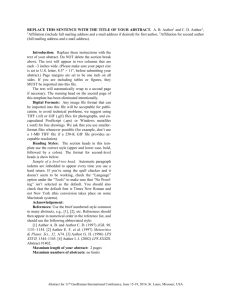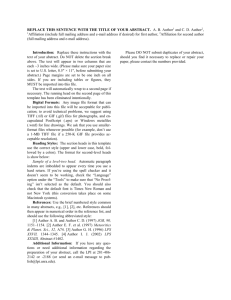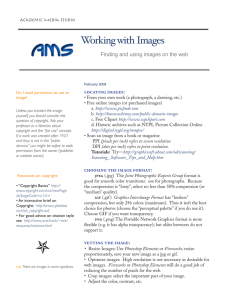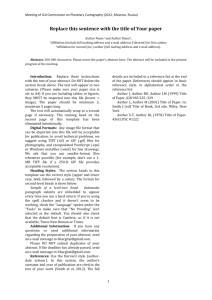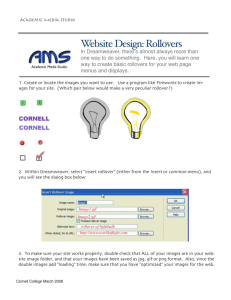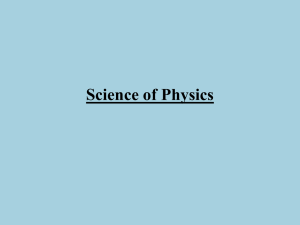Gravitoinertial Force Magnitude and Direction Influence Head-Centric Auditory Localization
advertisement
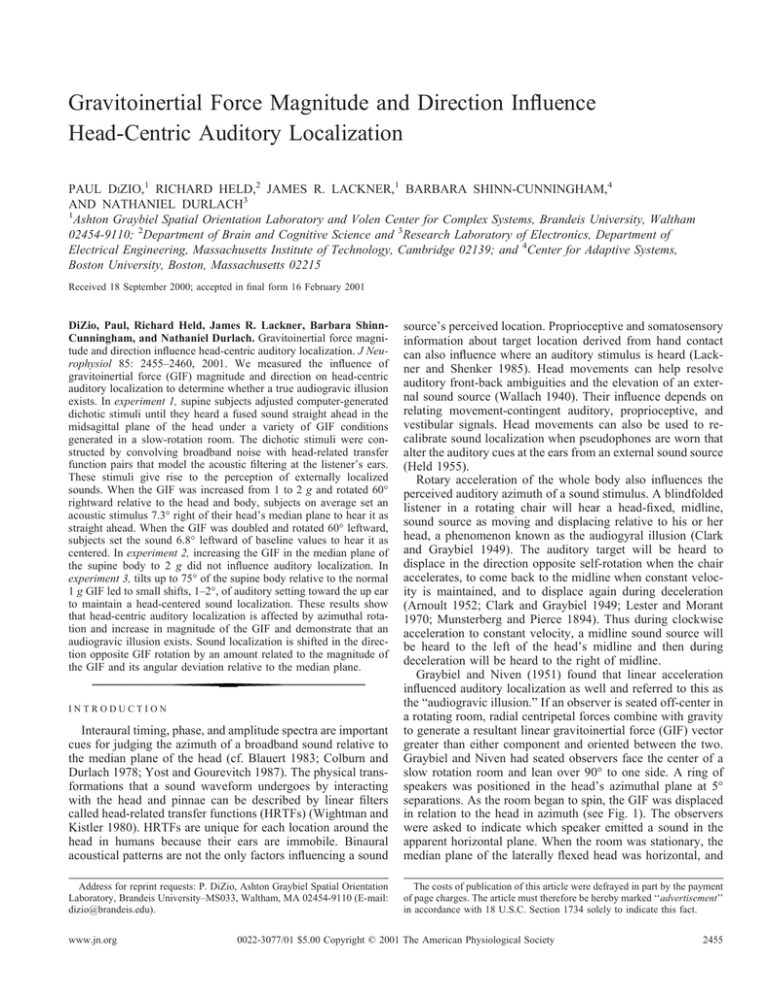
Gravitoinertial Force Magnitude and Direction Influence Head-Centric Auditory Localization PAUL DIZIO,1 RICHARD HELD,2 JAMES R. LACKNER,1 BARBARA SHINN-CUNNINGHAM,4 AND NATHANIEL DURLACH3 1 Ashton Graybiel Spatial Orientation Laboratory and Volen Center for Complex Systems, Brandeis University, Waltham 02454-9110; 2Department of Brain and Cognitive Science and 3Research Laboratory of Electronics, Department of Electrical Engineering, Massachusetts Institute of Technology, Cambridge 02139; and 4Center for Adaptive Systems, Boston University, Boston, Massachusetts 02215 Received 18 September 2000; accepted in final form 16 February 2001 DiZio, Paul, Richard Held, James R. Lackner, Barbara ShinnCunningham, and Nathaniel Durlach. Gravitoinertial force magnitude and direction influence head-centric auditory localization. J Neurophysiol 85: 2455–2460, 2001. We measured the influence of gravitoinertial force (GIF) magnitude and direction on head-centric auditory localization to determine whether a true audiogravic illusion exists. In experiment 1, supine subjects adjusted computer-generated dichotic stimuli until they heard a fused sound straight ahead in the midsagittal plane of the head under a variety of GIF conditions generated in a slow-rotation room. The dichotic stimuli were constructed by convolving broadband noise with head-related transfer function pairs that model the acoustic filtering at the listener’s ears. These stimuli give rise to the perception of externally localized sounds. When the GIF was increased from 1 to 2 g and rotated 60° rightward relative to the head and body, subjects on average set an acoustic stimulus 7.3° right of their head’s median plane to hear it as straight ahead. When the GIF was doubled and rotated 60° leftward, subjects set the sound 6.8° leftward of baseline values to hear it as centered. In experiment 2, increasing the GIF in the median plane of the supine body to 2 g did not influence auditory localization. In experiment 3, tilts up to 75° of the supine body relative to the normal 1 g GIF led to small shifts, 1–2°, of auditory setting toward the up ear to maintain a head-centered sound localization. These results show that head-centric auditory localization is affected by azimuthal rotation and increase in magnitude of the GIF and demonstrate that an audiogravic illusion exists. Sound localization is shifted in the direction opposite GIF rotation by an amount related to the magnitude of the GIF and its angular deviation relative to the median plane. Interaural timing, phase, and amplitude spectra are important cues for judging the azimuth of a broadband sound relative to the median plane of the head (cf. Blauert 1983; Colburn and Durlach 1978; Yost and Gourevitch 1987). The physical transformations that a sound waveform undergoes by interacting with the head and pinnae can be described by linear filters called head-related transfer functions (HRTFs) (Wightman and Kistler 1980). HRTFs are unique for each location around the head in humans because their ears are immobile. Binaural acoustical patterns are not the only factors influencing a sound source’s perceived location. Proprioceptive and somatosensory information about target location derived from hand contact can also influence where an auditory stimulus is heard (Lackner and Shenker 1985). Head movements can help resolve auditory front-back ambiguities and the elevation of an external sound source (Wallach 1940). Their influence depends on relating movement-contingent auditory, proprioceptive, and vestibular signals. Head movements can also be used to recalibrate sound localization when pseudophones are worn that alter the auditory cues at the ears from an external sound source (Held 1955). Rotary acceleration of the whole body also influences the perceived auditory azimuth of a sound stimulus. A blindfolded listener in a rotating chair will hear a head-fixed, midline, sound source as moving and displacing relative to his or her head, a phenomenon known as the audiogyral illusion (Clark and Graybiel 1949). The auditory target will be heard to displace in the direction opposite self-rotation when the chair accelerates, to come back to the midline when constant velocity is maintained, and to displace again during deceleration (Arnoult 1952; Clark and Graybiel 1949; Lester and Morant 1970; Munsterberg and Pierce 1894). Thus during clockwise acceleration to constant velocity, a midline sound source will be heard to the left of the head’s midline and then during deceleration will be heard to the right of midline. Graybiel and Niven (1951) found that linear acceleration influenced auditory localization as well and referred to this as the “audiogravic illusion.” If an observer is seated off-center in a rotating room, radial centripetal forces combine with gravity to generate a resultant linear gravitoinertial force (GIF) vector greater than either component and oriented between the two. Graybiel and Niven had seated observers face the center of a slow rotation room and lean over 90° to one side. A ring of speakers was positioned in the head’s azimuthal plane at 5° separations. As the room began to spin, the GIF was displaced in relation to the head in azimuth (see Fig. 1). The observers were asked to indicate which speaker emitted a sound in the apparent horizontal plane. When the room was stationary, the median plane of the laterally flexed head was horizontal, and Address for reprint requests: P. DiZio, Ashton Graybiel Spatial Orientation Laboratory, Brandeis University–MS033, Waltham, MA 02454-9110 (E-mail: dizio@brandeis.edu). The costs of publication of this article were defrayed in part by the payment of page charges. The article must therefore be hereby marked ‘‘advertisement’’ in accordance with 18 U.S.C. Section 1734 solely to indicate this fact. INTRODUCTION www.jn.org 0022-3077/01 $5.00 Copyright © 2001 The American Physiological Society 2455 2456 DIZIO, HELD, LACKNER, SHINN-CUNNINGHAM, AND DURLACH Knudsen 1987). Jay and Sparks (1984) have shown that the auditory receptive fields of visual-auditory units in the primate superior colliculus change as a function of eye position so that the auditory and visual maps stay in register. Spatially tuned auditory-visual neurons exist in the primate parietal cortex as well (Stricane et al. 1996). Psychophysical experiments have shown that eye position and head position can affect auditory localization in humans (Lewald and Ehrenstein 1996, 1998). In the cat auditory cortex, the representation of sound location is distributed over large populations of very broadly tuned neurons that respond to multiple acoustic parameters (Middlebrooks et al. 1998). Our investigation of vestibular and somatic influences on sound localization will further identify spatial reference frames for multi-modal neural coding. In addition, understanding audiogravic effects has potential practical applications in instruments providing orientation cues that pilots might use to prevent disorientation in unusual flight environments (Teas 1993). METHODS Experiment 1: twofold increase and 60° rotation of GIF FIG. 1. Schematic illustration of the audiogravic illusion in the experiment of Graybiel and Niven (1951). The subject sat at the periphery of a rotating room facing the center, leaning over to their side. At constant velocity the resultant (GIF) of gravity (g) and centrifugal force (Fcent) rotated (filled arrow) 29.2° in azimuth and increased to 1.146 g. The physical sound source (open dot) that subjects selected as being in the apparent horizontal plane was actually below the horizontal plane (filled dot). Fourteen subjects, nine males and five females, including two of the authors participated. Their ages ranged from 20 to 55 yr. The selection criteria included self-reports of normal hearing, balance, and posture and no general health restrictions that would make exposure to 2.0 g hazardous. The procedures used were approved by the Brandeis Human Subject Committee and were explained to subjects before they gave informed consent. observers correctly indicated a sound from the speaker located in that plane. When the room was spinning, the GIF was rotated inboard, and observers felt their whole body was tilted backward or outboard. They now identified as being in the horizontal plane sounds emitted by a speaker physically below the median plane of their head. Howard and Templeton (1966) and Howard (1982) have argued that this effect is not an audiogravic illusion but represents accurate auditory localization with respect to a changed reference frame. In other words, the subject feels tilted in relation to the horizontal and thus chooses a speaker that is displaced in relation to his or her body by the extent of the apparent self-tilt. Our goal in the present experiments was to determine whether a genuine audiogravic illusion exists such that sound localization vis a vis the head itself is altered. To do so, we measured head-centric auditory localization in azimuth during exposure to GIF transitions in a rotating room. Using headrelative instead of horizon-relative localization avoids the issue of a changed external reference frame for localization. We also used greater changes in GIF magnitude and direction and a more comfortable posture for the subjects than Graybiel and Niven. Our aims included determining whether changes in the angle of GIF, the magnitude of GIF, or a combination of the two lead to changes in head-relative auditory localization. We also wanted to observe the time course of any changes. Whether a head-relative audiogravic illusion exists has important theoretical implications. Binaural acoustic information such as interaural time and spectral differences are intrinsically in a head-centric frame of reference in humans. By contrast, neural maps in the colliculus of cats, animals with motile ears, have receptive fields defined in head-centric coordinates that include compensation for ear movements (Middlebrooks and APPARATUS. SUBJECTS. The experiment was performed in the Graybiel Laboratory slow rotation room (SRR), a circular enclosure 6.7 m in diameter powered by electric motors. A dedicated controller with a computer interface permits the programming of desired angular velocity profiles. The on-board equipment included a “bed” that could be tilted around its long axis, provisions for subject restraint, a system for generating spatially localizable sounds, and a joystick for the subject to indicate responses. Figure 2A illustrates the experimental situation. The bed held the subject supine, with his or her interaural axis co-linear with a radius of the room. The head’s midline was 2.5 m from the center of the room with either the right or left ear toward the center. The desired ear was oriented toward the center by repositioning the entire bed with respect to the SRR. A stiff, tight fitting foam mold surrounded the back and sides of the head, and elastic straps across the forehead and chin further immobilized the head. Earphones (Sennheiser, Model HD540 II) were embedded in the head mold. The body rested on a stiff form fitting foam pad, and foam side pads restricted lateral movement. Adjustable braces at the shoulders, hips, knees, and ankles and a chest plate further restricted possible movement during rotation. (Video measurements of how much the head could move in the head-restraint system during increases in magnitude and rotations of the GIF for the conditions in the three experiments of the present report indicated a typical range under 0.5°.) A Crystal River Convolvotron II board mounted in a PC was used to present acoustic stimuli over the earphones that gave rise to the perception of external sounds. The input to the system was squarewave modulated (4 Hz), Gaussian white noise (500 Hz to 20 kHz) from a Sony digital audio tape player. The Convolvotron has a set of HRTFs containing all the spatial cues normally present in the signals reaching each ear canal from sources at different positions around a listener’s head (Wenzel et al. 1993). The system generates signals for the left and right ears by convolving a monaural time series input with the pair of filters mapped to the desired location of the simulated sound. (Filters for nonmeasured positions are interpolated from adjacent measurements.) The subject could adjust the sound’s location by G-FORCE AFFECTS AUDITORY LOCALIZATION 2457 acceleration, six during constant velocity (GIF equal 2.0 g at 60° right of the median plane), seven during deceleration, and five each during the immediate and delayed postrotation periods. When a trial was completed, the computer saved the azimuthal angle of the stimulus chosen as being in the midline and the trial duration. In our nomenclature, 0° indicates stimulus settings actually to the median plane of the head, positive angles designate rightward settings relative to the head median plane, and negative leftward. Eleven subjects were positioned such that during rotation the GIF rotated rightward relative to their midsagittal plane (see Fig. 3) and eight were positioned so that it rotated leftward (including 5 of the 11, who were retested). Reversing the direction of GIF rotation relative to the subject was achieved by changing the orientation of the bed to have the subject’s other shoulder toward the wall of the room. The interaural axis was always aligned with a radius of the room, as in Fig. 2A. We took the average of a subject’s five prerotation midline settings and used this as the zero baseline for comparing the settings in the other periods of the experiment. The actual midline settings varied up to a degree from the ideal observer setting. FIG. 2. A: illustration of the experimental set up in the rotating room. The bed is shown in the earth-horizontal position, but it could rotate subjects around their long axis. The contoured foam restraints for the head and body are not shown, for clarity. Inset: how the subject used the joystick for adjusting the sound location. B: time series plots of normalized room angular velocity, GIF magnitude above 1 g and GIF angle relative to the subject’s median plane in experiment 1. Pre- and postrotation, GIF magnitude is 1.0 g and GIF angle is aligned with the median plane (0°). When angular velocity is ramping up to 152°/s, the GIF magnitude rises exponentially to 2.0 g and GIF angle sigmoidally approaches 60° right of the median plane. The deceleration patterns are the reverse of acceleration. means of a joystick connected to the PC through an A/D converter. Applying isometric torque to a sleeve (15 cm long ⫻ 2.5 cm diameter) around the joystick handle increased or decreased the azimuthal angle of the HRTF pair used by the Convolvotron. The rate of change in stimulus azimuth varied randomly between trials (12–18°/s). The subject depressed a button switch at the free end of the joystick handle to indicate when he or she was satisfied the sound was in the median plane of the head. PROCEDURE. The subjects were blindfolded throughout the experiment. They were always kept earth-horizontal while the magnitude and orientation of GIF were manipulated by rotating the SRR. In the prerotation baseline phase, the SRR was stationary while auditory settings to the midsagittal plane of the head were made over a 100-s period. In phase two, the SRR was accelerated at 1°/s2 for 152 s, held at 152°/s for 100 s, and decelerated to a stop at 1°/s2. At constant velocity the resultant GIF was tilted 60° with respect to the subject’s median plane and had a magnitude of 2.0 g. The third phase with the SRR stationary followed immediately and lasted for 100 s. A fourth identical phase followed after a 300-s delay. An entire run took 1,004 s. Figure 2B illustrates the SRR speed as well as GIF magnitude and direction during the rotation phase of a run. Figure 3A shows the experimental conditions during the baseline and constant velocity phases. Every 20 s during a run, the computer simulated a sound in the azimuthal plane at a random angle between 75° right and left of the head’s midsagittal plane. The blindfolded subject’s task was to use the joystick to bring the sound into the midsagittal plane of his or her head and then to press the thumb switch to indicate completion. The sound went off between trials. The subjects were given at least 20 prerotation practice trials before a run. They were warned that they would feel supine when the SRR was stationary and tilted when it was turning. They were instructed to make all auditory settings relative to their head rather than to external space. Five trials were run in the prerotation period (GIF equal 1.0 g at 0° to the median plane), seven during Experiment 2: twofold increase of GIF in the midsagittal plane We again doubled GIF magnitude but arranged for it to rotate into rather than out of alignment with the subject’s median plane. This allowed us to determine whether an increase in magnitude of GIF per se would elicit an audiogravic illusion or whether a displacement relative to the sagittal plane is also necessary. FIG. 3. Schematic of experimental conditions. The same rotating room angular velocity profile (—) was used in experiments 1 and 2. A: in experiment 1, the subject was always supine, so the GIF vector equaled 1.0 g in the median plane while the room was stationary. At constant velocity rotation, a centrifugal force directed into the right ear produced a resultant GIF of 2.0 g oriented 60° right of the median plane. If the subject lay supine with his or her left ear toward the center (not shown), then the GIF rotated 60° leftward relative to the subject’s median plane. B: in experiment 2, subjects were tilted 60° right ear down about their long axis. With the room stationary, the GIF vector equaled 1.0 g, 60° left of the median plane; during constant velocity rotation, the resultant GIF was 2.0 g in the median plane. C: in experiment 3, the supine subjects were tilted about their z axis in 15° increments up to 75° left or right ear down. The room was always stationary. Only the extreme left and right ear down tilts are illustrated. 2458 DIZIO, HELD, LACKNER, SHINN-CUNNINGHAM, AND DURLACH Ten subjects participated. Nine had been in experiment 1, including two of the authors. All gave informed consent to the Human Subject Committee approved protocol. The apparatus and procedure were the same as in experiment 1 with one exception. The restrained subject was tilted 60° right ear down from the supine position toward the center of the rotating room (see Fig. 3B). In the no-rotation periods, the GIF equaled 1.0 g and was oriented 60° left of the subject’s median plane; when the room was rotating at 152°/s constant velocity, the GIF equaled 2.0 g and was aligned with the subject’s median plane. The average of the five prerotation midline settings for each subject was taken as his or her zero baseline. Experiment 3: tilt of the median plane in a normal 1.0 g environment Six subjects who had participated in the prior experiments took part. The rotating room was always stationary so that the GIF was always 1.0 g. The subject’s orientation to gravity was set to 1 of 11 bed angles around the z-axis between 75° right and left at 15° increments (see Fig. 3C). Subjects made auditory settings to center a sound in the head’s median plane as in the earlier experiments. The bed angles were presented in random order and each angle was repeated six times within a session. A position was held long enough for the subject to make one setting and then the bed was manually moved to a new position. RESULTS Experiment 1 Figure 4A shows the averaged sequential auditory midline settings for subjects exposed to rightward rotation of the GIF relative to the midsagittal plane. During acceleration, auditory settings shifted to the right relative to the 1.0 g baseline and then plateaued at constant velocity (GIF equal 2.0 g, tilted 60° right re the head). In the six trials done at constant velocity, subjects indicated as being straight ahead auditory stimuli 7.3 ⫾ 4.17° (mean ⫾ SD) right of the baseline settings. During deceleration, settings shifted back toward prerotation baseline, reaching their resting level before the room came to a stop. In the immediate postrotation period, the average auditory setting was 2.98 ⫾ 6.031° left of prerotation. This value was virtually unchanged five minutes later, 3.01 ⫾ 5.4° left of baseline. ANOVA (SPSS MANOVA procedure) revealed significant differences [F(3,30) ⫽ 4.73, P ⫽ 0.008] among the four steady GIF periods—prerotation, constant velocity, immediate postrotation, and delayed postrotation. Pairwise contrasts indicated that auditory settings in the constant velocity phase differed significantly from each of the no-rotation conditions (P ⬍ 0.026 at least), but the no-rotation conditions did not differ from one another. An ANOVA was also performed to test for differences in trial-to-trial variability across the steady GIF periods. The standard deviation of each subject’s settings in each GIF period was used as a measure of variability. The overall test was significant [F(3,30) ⫽ 4.02, P ⫽ 0.034]. The constant velocity condition was significantly more variable (7.19° standard deviation) than the three no-rotation conditions collectively (5.28°), P ⬍ 0.05. It took on average of 6.9 s to complete an auditory setting. There was no effect of rotation on the time to make a setting. Figure 4B shows the auditory midline settings of the subjects who were exposed to a leftward shift of the GIF during rotation. Their results were directionally opposite to those tested with rightward GIF rotation. During acceleration, auditory settings shifted leftward relative to baseline and at constant velocity rotation peaked at 6.8° leftward. During deceleration, the settings shifted back toward prerotation baseline and were at baseline by the time the room fully stopped. As with the subjects exposed to rightward displacement of the GIF, a MANOVA indicated that auditory settings varied significantly across the prerotation, constant velocity, immediate postrotation, and final postrotation periods [F(3,13) ⫽ 34.6, P ⫽ 0.004]. Only the constant velocity period settings differed significantly from the other conditions in pairwise comparisons. The trial-to-trial variability (standard deviation) was also greater in the constant velocity period compared with the other three periods. Experiment 2 The results are plotted in Fig. 5. There was very little shift relative to prerotation baseline during acceleration, settings averaged 2.3° right of baseline during constant velocity, 0.37° right immediately postrotation and 1.66° left in the delayed postrotation period. Analysis of variance revealed no significant difference among the four periods [F(3,27) ⫽ 1.74, P ⫽ 0.182]. FIG. 4. Plot of average sound settings (relative to prerotation baseline) and room angular velocity vs. time for experiment 1. A: at constant velocity (100-s duration), GIF magnitude ⫽ 2.0 g, GIF direction ⫽ 60° right of the median plane (A, n ⫽ 11) or 60° left of the median plane (B, n ⫽ 8). Experiment 3 The results are presented in terms of angles of the GIF relative to the subject’s median plane with positive angles G-FORCE AFFECTS AUDITORY LOCALIZATION 2459 General discussion FIG. 5. Plot of average sound settings, relative to baseline (n ⫽ 10), and room angular velocity vs. time in experiment 2. GIF magnitude ⫽ 2.0 g, GIF aligned with the median plane for 100 s at constant velocity. representing rightward displacement of the GIF in relation to the median plane. The midline settings at zero tilt angle were used as the baseline reference value. Each subject’s six repeated settings at the same tilt angle were averaged and linear regression lines were fit to the auditory settings versus GIF tilt. Statistical comparisons were made of the average slopes. Figure 6 summarizes the results. In tilted conditions, the settings shifted slightly but systematically in the direction that the GIF rotated. The average slope was only 0.05, but this was significantly different from 0 (t ⫽ ⫺6.497, P ⬍ 0.001) because the results were very consistent from subject to subject. DISCUSSION Experiment 1 The observations in experiment 1 unequivocally confirm the existence of an audiogravic illusion when the GIF vector is increased in magnitude and rotated away from the median plane of the head. Sounds must be shifted in the same direction as the rotation of the GIF relative to head azimuth to be perceived in the head’s median plane. We conclude that a true audiogravic illusion exists in the form of a head-relative shift in auditory localization during exposure to a changing linear GIF resultant. The apparent direction of an auditory target shifts in the same plane but in the opposite direction to the displacement of the GIF resultant. In other words, increasing the magnitude of the GIF resultant and changing its direction relative to the head and torso induces an apparent displacement of a sound source relative to the head in the opposite direction. In their original study, Graybiel and Niven (1951) used ambient sound sources and had subjects make localization judgments relative to the apparent horizontal. They observed changes in auditory settings that corresponded to about 80% of the angular displacement of the GIF resultant. Howard (Howard 1982; Howard and Templeton 1966) argued that this shift does not represent an illusion but is a change attributable to using a new reference frame, that what needs to be explained is why the shift is not 100%. The head relative shifts we have observed in the present study correspond to about 20% of the shift of the GIF resultant. The Graybiel and Niven (1951) results thus reflect a reference frame shift and a true audiogravic illusion. We have found that a shift in sound lateralization is produced if the GIF resultant rotates away from the median plane and simultaneously increases in magnitude from 1.0 to 2.0 g. There is little or no bias if the GIF rotates into alignment with the median plane during the transition from 1.0 to 2.0 g. The auditory shifts are tightly coupled to temporal changes in GIF, and they return to baseline without significant aftereffects on return to a 1 g GIF. The small change in auditory localization associated with rotating the GIF relative to the sagittal plane of the head complements and is consistent with the findings of Lewald and Ehrenstein (1998), who found that turning the head relative to the torso without changing gravitoinertial orientation induces the same direction of auditory shift. The existence of an audiogravic illusion indicates an additional level of representation or analysis in computational neural maps subserving auditory localization. HRTF pairs encode target location in an intrinsic head-centric coordinate Experiment 2 The results in experiment 2 indicate that an audiogravic illusion does not occur when the GIF doubles and rotates into the median plane of the head and body. The absence of an auditory shift in this condition and the significant shifts seen in experiment 1 indicate that an increase in GIF magnitude in the sagittal plane is not sufficient to cause an audiogravic illusion but that a rotation of the GIF vector is necessary for the shift in localization to be induced. The final experiment determined how auditory localization would be affected by the direction of the GIF vector when its magnitude was always 1 g. The findings in experiment 3 point to small but systematic changes in perceived azimuth of an acoustic stimulus when a subject is reoriented in a normal terrestrial force background. A rightward rotation of GIF relative to the median plane requires a rightward shift of auditory settings for a sound to be heard in the subject’s median plane. The direction of this effect is consistent with what was observed in amplified fashion at 2.0 g in experiment 1. FIG. 6. Plot of average sound settings, relative to baseline (n ⫽ 6), for subjects in experiment 3 tilted ⫾75° from supine about the horizontal z axis in stationary, 1.0 g conditions. The linear regression line fitting the data is significantly different from 0 because the 95% confidence interval (CI) around the line is quite small. 2460 DIZIO, HELD, LACKNER, SHINN-CUNNINGHAM, AND DURLACH system. Psychophysical mappings of HRTF information to perceived azimuth have been established empirically (Wightman and Kistler 1989). However, the relationship between physical acoustic information (HRTFs) and perceived spatial location is remapped by alterations in GIF. This means the neural computations underlying sound localization interrelate binaural auditory HRTF information about the acoustic target with vestibular, proprioceptive, and somatosensory representations of GIF direction and magnitude. The GIF influence on auditory localization may act at a level that affects sensory localization in multiple modalities. For example, a comparison of the audiogravic and oculogravic illusions suggests that alterations in GIF may have parallel effects on auditory and visual localization. The oculogravic illusion is a change in the perceived position or orientation of an object that is physically stationary in relation to an observer when the observer is exposed to a change in direction and magnitude of the GIF vector (Corriea et al. 1968; Graybiel 1952; Miller and Graybiel 1968). The audiogravic and oculogravic illusions are similar—stationary auditory and visual targets appear to move and displace in the direction opposite the rotation of a supra-1 g GIF resultant. The audiogravic illusion we have demonstrated is with respect to the head’s azimuthal plane while the oculogravic illusion has been tested primarily in the sagittal and frontal planes. Nevertheless, the similarity between the oculogravic and audiogravic illusions raises the possibility of parallel changes in visual and auditory spatial representations or of a common change altering multisensory localization. We have, in fact, completed studies of the oculogravic illusion during changes of GIF in azimuth and find that it matches the audiogravic illusion in amplitude and timing (DiZio, Lackner, and Held, unpublished data) This implies a common mechanism subserving both illusions, one in which the assignment of spatial direction relative to the head involves signals specifying body orientation in relation to the resultant GIF vector. Parietal cortex contains representations of the necessary reference frames for implementing such a transformation (cf. Andersen et al. 1997; Colby and Duhamel 1996; Kalaska et al. 1997; Stein and Meredith 1993). This work was supported by Air Force Office of Scientific Research Contract F49620110171. REFERENCES ANDERSEN RA, SNYDER LH, BRADLEY D, AND ZING J. Multimodal representation of space in the posterior parietal cortex and its use in planning movements. Annu Rev Neurosci 20: 303–330, 1997. ARNOULT MD. The localization of sound during rotation of the visual environment. Am J Psychol 65: 48 –58, 1952. BLAUERT J. Spatial Hearing. Cambridge, MA: MIT Press, 1983. CLARK B AND GRAYBIEL A. The effect of angular acceleration on sound localization: the audiogyral illusion. J Psychol 28: 235–244, 1949. COLBURN HS AND DURLACH NI. Models of binocular interaction. In: Handbook of Perception, edited by Carterette EC and Friedman MP. New York: Academic, 1978. COLBY C AND DUHAMEL J-R. Spatial representation for action in parietal cortex. Cereb Cortex 5: 105–115, 1996. CORRIEA MJ, HIXSON WC, AND NIVEN JI. On predictive equations for subjective judgments of vertical in a force field. Acta Otolaryngol 230: 3–20, 1968. GRAYBIEL A. The oculogravic illusion. AMA Arch Ophthal 48: 605– 615, 1952. GRAYBIEL A AND NIVEN JI. The effect of a change in direction of resultant force on sound localization: the audiogravic illusion. J Exp Psychol 42: 227–230, 1951. HELD R. Shift in binaural localization after prolonged exposure to atypical combinations of stimuli. Am J Psychol 68: 526 –548, 1955. HOWARD IP. Visual Orientation. New York: Wiley, 1982. HOWARD IP AND TEMPLETON WB. Human Spatial Orientation. London: Wiley, 1966. JAY MF AND SPARKS DL. Auditory receptive fields in primate superior colliculus shift with changes in eye position. Nature 309: 345–347, 1980. KALASKA JF, SCOTT SH, CISEK P, AND SERGIO L. Cortical control of reaching movements. Curr Opinion Neurobiol 7: 849 – 859, 1997. LACKNER JR AND SHENKER B. Proprioceptive influences on auditory and visual spatial localization. J Neurosci 5: 579 –583, 1985. LESTER G AND MORANT RB. Apparent sound displacement during vestibular stimulation. Am J Psychol 83: 554 –566, 1970. LEWALD J AND EHRENSTEIN WH. The effect of eye position on auditory lateralization. Exp Brain Res 108: 473– 485, 1996. LEWALD J AND EHRENSTEIN WH. Influence of head-to-trunk position on sound lateralization. Exp Brain Res 121: 230 –238, 1998. MIDDLEBROOKS JC, XU L, EDDINS AC, AND GREEN DM. Codes for sound source location in nontonotopic auditory cortex. J Neurophysiol 80: 863– 881, 1998. MIDDLEBROOKS JC AND KNUDSEN EI. Changes in external ear position modify the spatial tuning of auditory units in the cat’s superior colliculus. J Neurophysiol 57: 672– 687, 1987. MILLER EF AND GRAYBIEL A. Visual horizontal perception in relation to otolith function. Am J Psychol 81: 488 – 496, 1968. MUNSTERBERG H AND PIERCE AH. The localization of sound. Psychol Rev 1: 416 – 476, 1894. STEIN BE AND MEREDITH MA. The Merging of the Senses. Cambridge, MA: MIT Press, 1993. STRICANE B, ANDERSON RA, AND MAZZONI P. Eye-centered, head-centered and intermediate coding of remembered sound locations in area LIP. J Neurophysiol 76: 2071–2076, 1996. TEAS DC. A Virtual Acoustic Orientation Instrument. Brooks AFB, TX: Armstrong Laboratory Report, AL-TR-1992-1057, 1993. WALLACH H. The role of head movements and vestibular and visual cues in sound localization. J Exp Psychol 27: 339 –368, 1940. WENZEL EM, ARRUDA M, KISTLER DJ, AND WIGHTMAN FL. Localization using nonindividualized head-related transfer-functions. J Acoust Soc Am 94: 111–123, 1993. WIGHTMAN FL AND KISTLER DJ. A new look at auditory space perception. In: Psychophysical, Physiological and Behavioral Studies in Hearing, edited by vander Brink G and Bilsen FA. Delft: University Press, 1980, p. 441– 448. WIGHTMAN FL AND KISTLER DJ. Headphone simulation of free-field listening. II. Psychophysical validation. J Acoust Soc Am 85: 868 – 878, 1989. YOST WA AND GOUREVITCH G. Directional Hearing. New York: SpringerVerlag, 1987.

